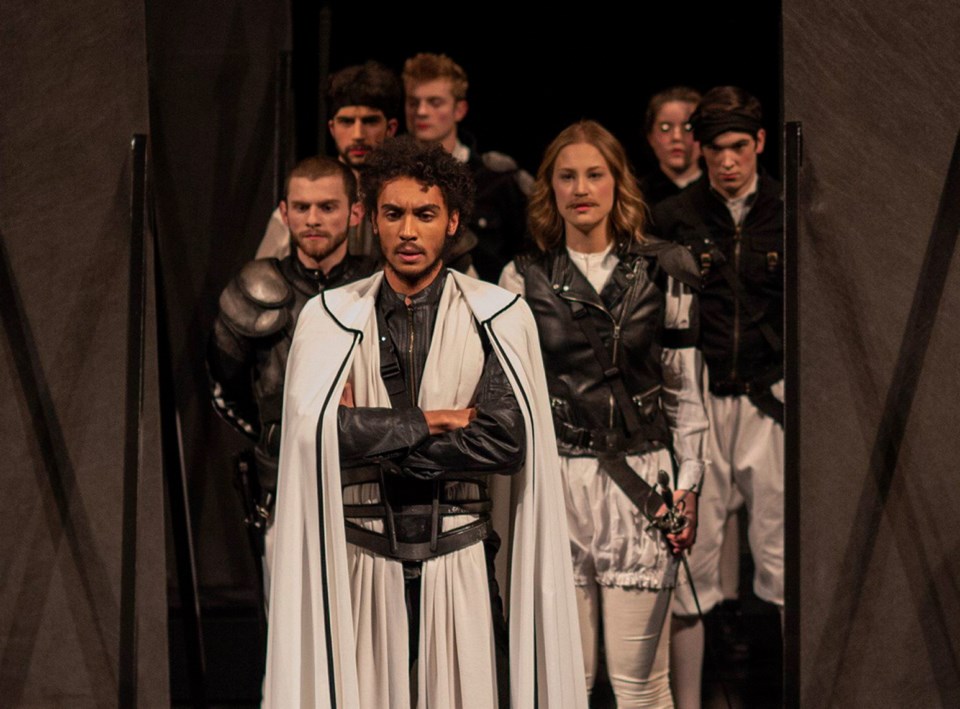Brian Richmond, who directs the University of Victoria’s visually spectacular new staging of Othello, notes that the show was 12 long months in the making. I’m not surprised. Staging this tragedy — one of Shakespeare’s longest — is a herculean task for anyone brave enough attempt it.
UVic’s history-making production (it’s the first time the theatre department has mounted it) clocks in at a touch over three hours, despite the fact 10 per cent of the script has been judiciously trimmed.
Don’t be daunted. Take a power nap beforehand and dive in — the rewards are there.
Written in 1604, Othello poses several problems for modern companies and audiences. In years past, the title role was often played in blackface by white actors (famously Laurence Olivier). As anyone who followed Canada’s federal election knows, this sort of thing doesn’t fly in 2019. UVic neatly resolves the issue by casting Tallas Munro, a tall and imposing actor with coffee-coloured skin, as the Moor.
Another problem, less easily solved, is that of Desdemona. In the play, Othello’s love for his wife is eroded by villainous Iago. Othello’s reverence turns to jealousy-fuelled hatred and abuse, both mental and physical (at one point, he viciously strikes his wife on the face).
Shakespeare has Desdemona more or less taking it — an attitude that seems perplexing in the MeToo era. (One audience member, upon leaving, remarked to me that the depiction of Desdemona had her gnashing her teeth.)
Perhaps future directors will solve the problem by having Desdemona pull a pistol — or at least a karate chop or two — on Othello. Of course, that would completely upend Shakespeare’s intent and Richmond wisely leaves it be.
Othello is an immense challenge for professionals, let alone students. Thursday’s opening night show revealed several commendable performances. Yet what most impresses is the overall handling of the play.
Richmond and his team have opted for a stylish black-and-white look that works wonderfully.
Nothing beats the opening scene. A cast of 25, all wearing white, files solemnly onto the Chief Dan George Theatre’s thrust stage and engages in a courtly dance. A masked girl, also in white, stands atop a movable staircase to sing a beautiful song, backed by strings and guitar. The music, most of it live, was superb throughout.
The introductory sequence is set in Venice, something we’re reminded of as the siren continues to sing while another actor poles a “gondola” — a small wheeled platform. The effect was enchanting. This unified sense of spectacle and beauty is maintained. It’s a credit to the talents of set designers Conor Farrell and Logan Swain, as well as Emily Friesen, an imaginative costume designer who does wonders with (what looks like) hockey pads.
With a practised eye, choreographer Jacques Lemay ensures Othello is replete with harmonious movement, ranging from the stately to raucous booze-ups and rapier-clinking fights.
It’s tempting to view Othello as a parable for what’s happening south of the border. The hateful and Machiavellian Iago poisons the minds of others to glean power and wreak senseless destruction. The character, a devil in contrast to Desdemona’s angel, hoodwinks not only Othello, but Roderigo and Cassio as well.
Iago is by far the juiciest role and Ciaran Volke manages it with cleverness and complexity. His Irish-accented villain is both evil and — in the tradition of the best sociopaths — curiously charming.
When Iago addresses the audience directly to reveal diabolical plans, there’s an odd likeability at work. Volke is believable as both baddy and duplicitous buddy, a duality that’s key to a successful interpretation of the role.
Grace Fedorchuk impressed by creating a fully three-dimensional character out of Emelia — a fine example of an actor standing out in a support role. Also notable was Una Rekic, sporting a mustache to play Cassio. Rekic convincingly conveyed the rascally rake with a stout heart, kissing women and fighting men with gusto. The role of Desdemona’s father, Branbantio, is gender-switched to Brabantia, with Sarah Hunsberger offering a rather broad interpretation of the role.
Munro — at times looking the rock star with a Prince haircut and leather trousers — captured Othello’s dignity and regal stage presence. On this night, the long speeches too often came off as a mere recitation of words. Still, the actor warmed up in the final scene, managing to convey Othello’s sense of nobility in the face of heartbreak.
Georgia Duff is well cast as the angelically beautiful Desdemona. Yet she, too, was challenged by the task of making the words truly jump off the page (granted, Desdemona is more of a two-dimensional figure than Othello). There could be a greater sense of chemistry between Othello and Desdemona, something that will, perhaps, develop as the run continues.
These are, of course, immense roles and the entire student cast must be commended for offering a well-rehearsed performance.
Othello continues at the University of Victoria to Nov. 23.



